The Pyramids Variations
Developing the Bass Line (2)
Bass lines in six-eight with RH first inversion chords
It’s a good idea to sketch these developed bass lines in six-eight. You can hear the musical logic of the bass line a lot better and develop your ideas more easily without the long wait in the twelve-eight bar.
Here's a sample module performance.
You can still ‘stretch out’ these bass lines and play them in twelve-eight. But if you learn right hand ‘first inversion chords’ for the Pyramids chord sequence, you can play these developed bass lines in six-eight. This will make experimenting a lot quicker and more efficient, as well as giving you another Pyramids variation to play.
First inversion Pyramids chords
The official name for a Basic Music-making Position (BMP) chord is ‘a triad in root position’ – ‘triad’ because it has three notes (like tripod and tricycle), and ‘root position’, which tells us the lowest note is the root (the name-note).
We can tip root position triads upside down and get other useful chords called inversions. If we take the bottom note and move it up an octave – to the next note of the same letter name, we get a first inversion chord, with the root at the top. The other two notes stay in the same place.
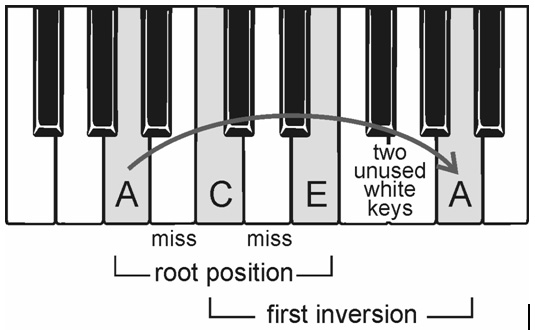
Note that the new top note is also the ‘LH-over note’ in the LH-over pattern:
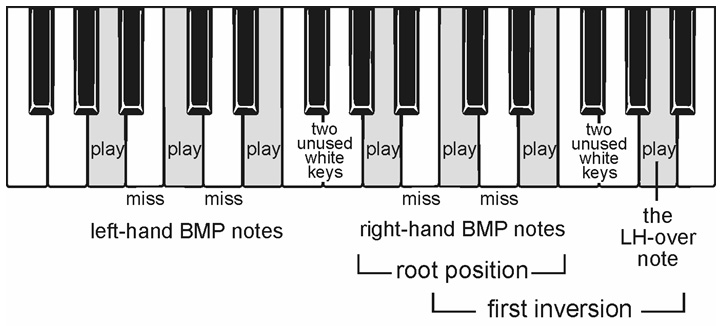
To make this new version of Pyramids using first inversion chords, we need first inversions of all the right hand BMP chords in the Pyramids chord sequence.

To find the inversions, we first ‘squash’ the broken chords
back into line. (Audio for this section is two illustrations down.)

Then we move the lowest note (the root, or name-note) up an octave, to the top. The other two notes stay in the same place. The root position chord becomes the first inversion of the same chord.

Looking more closely at a few examples.
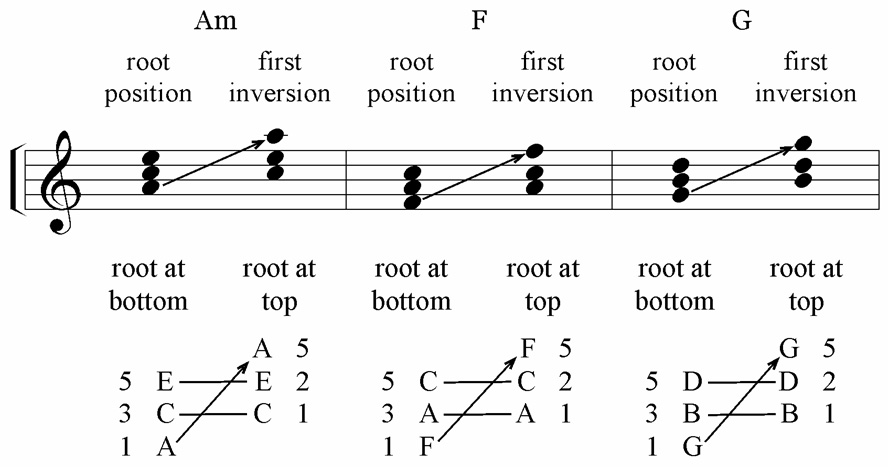
Notice that you are asked to use right hand finger 2 for the middle note of the first inversion chord, instead of finger 3. This helps keep the back of the hand flat. Make an effort to get into the habit of using finger 2 for right-hand first inversion chords.
Next, spread the first inversion chords back out, leaving quaver slots for the root and the two ‘movement type’ approach notes in the left hand. Here is an example.
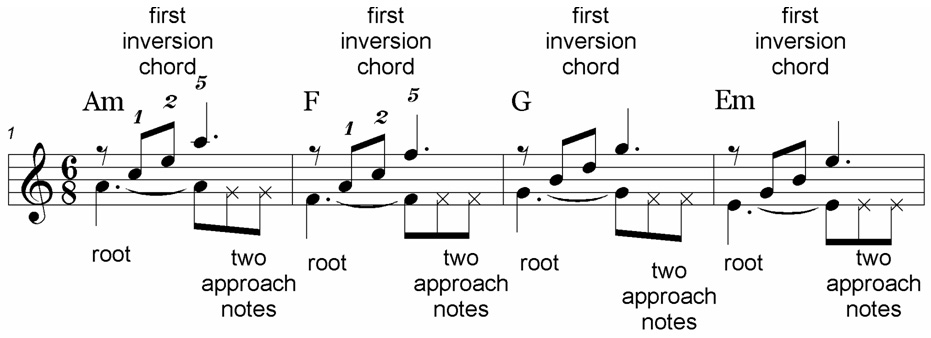
Notice these three things.
- The music is all written on one treble clef stave. You have not seen the bass line written in the treble clef before, but the first note in the bar is always the chord root, named in the chord symbol.
- The stems-up notes in the music are the right hand notes – the first inversion chords. The stems-down notes are the left hand developed bass line notes.
- The left hand plays only the bass line notes, and no chords. The right hand plays only the new first inversion chords.
The phantom cross-head notes stand for any of the movement type approach notes you choose.
Developed bass lines with RH first inversion chords
There are already three complete developed bass lines which you can now play in six-eight in the treble clef with right hand first inversion chords.
Developed bass line, Types One and Two

This is the performance given for the 'phantom (cross-head) approach notes' example above.
Developed bass line, mixed Types One, Two and Three
(This music is written out in your Workbook.)

Here's the scrolling MS video of the performance again.
Watch it on Mister Musicarta YouTube
Here's the Types Two and Three only chart and performance.

Here is a reminder of the approach movements used.
 |
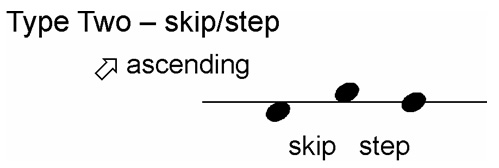 |
 |
 |
 |
Some new bass line patterns
You can create many different bass lines by making simple rules about how the approach notes are allowed to move.
We’ll explore these possible variations in six-eight in the treble clef. For a longer version, you can always stretch the bass line out to fill the gaps between 10-note LH-over patterns in twelve-eight, with the left hand in the bass clef and the hands an octave lower in their original position.
Here are some of the new rules we might try out. First, let’s first scrap the rule that says we have to repeat the existing root note in the first quaver slot. Now we have two quaver slots to experiment with.
New Rule One
- Use only Basic Music-making Position (BMP) chord tones, but never use the same note twice in a row.
Here is the bass line this rule produces.

Try to finish the whole chord sequence like this.
If we drop the part of New Rule One which says “never use the same note twice in a row”, we could create the following variation, where the bass note repeats in the even-numbered bars (2, 4, and so on).

Place the right hand first inversion chords as before and finish the bass line. Does the movement in the even-numbered bars sounds better than before? These little differences make the bass lines more interesting for the listener. Notice that the bass line suggested here has a two-bar repeating pattern, where the odd-numbered bars follow one pattern, and the even-numbered bars follow another.
(The Developed Bass Lines with RH First Inversion Chords, Mixed Types One, Two and Three MS is in your Workbook at this point.)
New Rule Two
New Rule Two is:
- Approach the new root using only steps.

New Rule Two also generates the following variation. (The different movement is in the even-numbered bars.)

Add the right hand first inversion chords and carry these
two patterns right through the chord sequence.
More bass lines, combining different movements
The best bass lines combine different types of approach movement. Here are the first bars of some examples. Both are two-bar patterns, with one type of approach movement in the odd-numbered bars, and another type in the even-numbered bars. Work out what the two movement patterns are and complete the bass lines.
New Rule Three

New Rule Four

In the end, you will probably decide on a favourite bass line which combines several different movements. “Because I like it!” is a perfectly good ‘rule’, although sometimes the deciding factor will be that you feel a particular type of movement in a certain place definitely doesn’t work. (Rule: “Because I don't like it!”)
First inversions in bars 7 and 8, 15 and 16
(See the video at the end of this section.)
For the ends of the two halves of Pyramids, the chord charts suggest using the original LH-over pattern – the two root position chords with a LH-over note.
At the end of the first half:

And at the end of the second half:

In practice, you will tend to repeat the RH first inversion chord in bar 8 and pass the LH over in search of further e major chord tones (see next MS example). This is, of course, quite 'correct'. The important thing is appreciating that some E major chord tones are required to fill out the bars and complete the LH-over pattern.

Using a first inversion in the LH is of course quite logical at the end of the second half.

The audio files because sound exactly the same. You can see the difference in this video (or if you play the files on MidiPiano): the 'official' version (M20) is the top keyboard; the changed version (M21) is the bottom keyboard.
Tip: Watch the keyboards one at a time until you see the difference.)
Improvising
There are two benefits from studying the ways that the bass can move between roots in such detail. The first is that thinking about and listening for steps, skips and jumps in music will help you work out by ear any music you want to play, whether it’s in your head or on a CD. Does the melody or the bass line stay on the same note, or go up or down? By how much? A little or a lot? A step, a skip or a jump?
The second benefit is that playing lots of slightly different variations of the same thing prepares you to improvise. Improvising is the ability to play music that you hear in your head, but remember that we are not picking the notes out of thin air. We are improvising on a chord sequence, with known ‘target notes’ (the roots), moving in well-rehearsed ways.
A good 'half-way house' in improvising is to confidently play options from a well-rehearsed set even if you don’t know exactly what the result will sound like. The bass line approach note movement types are just such a set of options.
Finally, remember that you cannot learn to improvise unless you are willing to make a few mistakes along the way!
Adding developed bass lines to Pyramids
The next challenge is to play developed bass lines under the six Basic Music-making Position notes of the Pyramids First Performance. The Pyramids First Performance can be played in the treble clef, as shown below, or the whole piece can be taken down an octave.
The left hand plays the BMP chord tones and then, as the right hand plays its BMP chord tones, it plays the moving bass line approach notes.
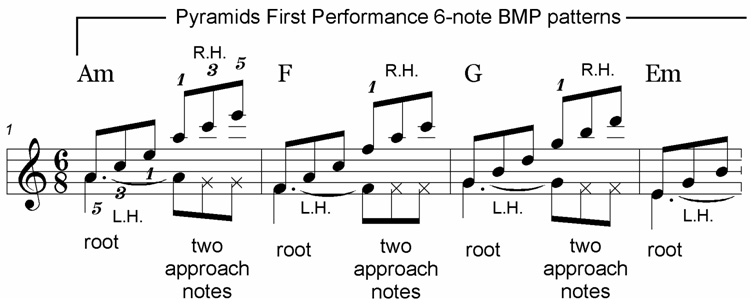
Another creative exercise would be to stretch out all these bass lines out to fill the gaps between 10-note LH-over patterns in twelve-eight. Use any chord chart to remind yourself of the chord sequence and the pattern of the roots.
Note than you can play all these versions an octave lower, if you prefer the sound. The Workbook has some bass lines written an octave down - try them with LH-over patterns in 12-8 or RH first-inversion chords in 6-8.
|
OUT NOW! |
THE MUSICARTA BEAT & RHYTHM WORKBOOK At last! An effective approach to keyboard rhythm & syncopation skills. Learn more! |
ONLY $24.95! |
PYRAMIDS
|
The MusicartaA methodical approach to keyboard syncopation for
|
PUBLICATIONS
exciting keyboard
creativity courses
CHORDS 101
WORKBOOK

~HANON~
video course

Musicarta
Patreon
PENTATONICS
WORKBOOK
video course

Creative Keyboard
video course

BEAT AND RHYTHM
WORKBOOK

- Volume 1 -

12-BAR PIANO
STYLES WORKBOOK

MUSICARTA MODES
WORKBOOK

PIANO STYLE

CANON PROJECT
video course

VARIATIONS
video course


- Piano Solo -
video course

- Piano Solo -


YouTube playlists





 THE LOGO
THE LOGO
